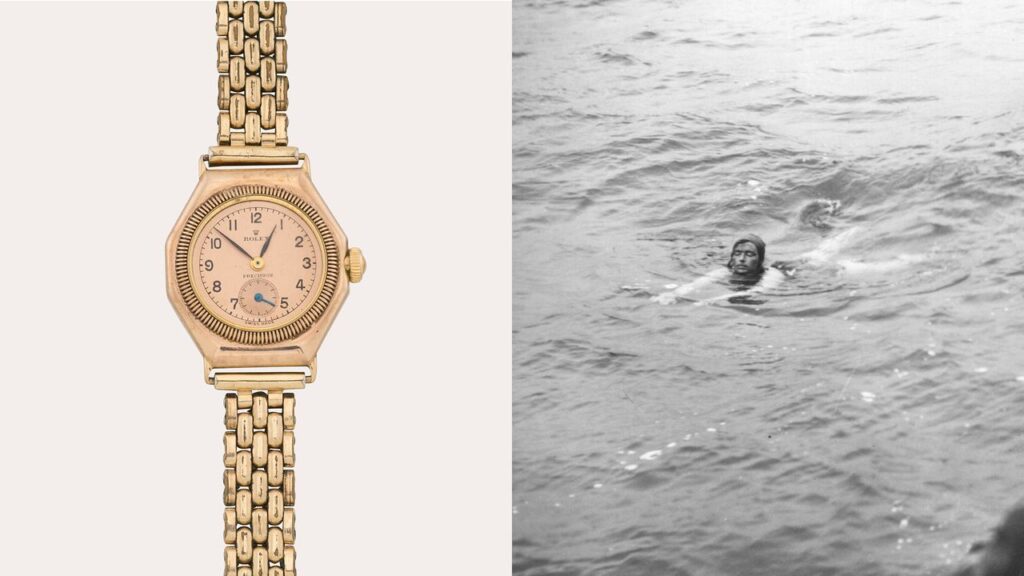The “Paul Newman” Daytona. The “Bao Dai.” The Oyster Perpetual that scaled Everest. All of these pieces carry significant historical importance—not only for Rolex, but for the broader watch world. But long before these pieces rolled off the Crown’s assembly line, one humble little gold timepiece changed the course of horological history—and few people have ever heard of it.
In the early 1920s, Mercedes Gleitze, a young multilingual English secretary of German descent, made the first of several attempts to swim the English Channel. A recreational athlete, she had begun swimming longer and longer stretches of the Thames in her spare time, testing her endurance. While it would ultimately be an American named Gertrude Ederle—also of German descent—who would become the first woman to successfully swim the Channel in 1926, Gleitze was inspired to become the first British woman to attempt the crossing. Departing from Cap Gris-Nez near Calais on the French coast, she completed this impressive feat in 15 hours and 15 minutes on October 7, 1927.
Before Gleitze could enjoy her victory, however, a rival swimmer claimed to have beaten her to the punch. Though this individual quickly admitted to the press that her claim was false, Gleitze had already committed to make a second crossing in defense of her title, which was scheduled for October 21st. By this time, Gleitze’s story had spread far and wide, having come to the attention of none other than Rolex founder Hans Wilsdorf. For several years, Wilsdorf had been purchasing and improving upon patents pertaining to screw-down crowns—a critical component of a fully waterproof watch housing. By 1926, he applied for a patent for his new “Oyster” case which, when combined with his “Perpetual” automatic movement in the 1930s, would later form the Oyster Perpetual—the basis of every modern automatic Rolex watch.
Courtesy of Sotheby’s
Courtesy of Sotheby’s
Knowing that the upcoming “Vindication Swim” would be widely covered by the press, Wilsdorf reached out to Gleitze and arranged for her to wear a (patent-pending) Rolex Oyster watch secured around her neck by a ribbon while in the Channel. As predicted, the swim indeed drew enormous publicity, with members of the press (as well as family and friends) following in boats, and an airplane chartered by The Daily Mail flying overhead to take photographs. Conditions in the Channel were too rough, however, and Gleitze had to abandon the crossing after 10 hours and 24 minutes.
The abandonment of the swim didn’t particularly matter, however, for two reasons: First, the newly formed Channel Swimming Association voted to uphold Gleitze’s record as the first Englishwoman to swim the Channel, restoring her questioned honor. Secondly, the involvement of Rolex was an absolute coup for both the brand as well as for Gleitze. Taking out a full-page ad in the Daily Mail, Rolex referred to its Oyster as “the watch that defied the Channel” and that “kept time despite being immersed in water for over ten hours.” Indeed, as Gleitze herself testified, the humble gold watch endured “a temp of not more than 58 [degrees] and often as low as 51.” Gleitze herself became Rolex’s very first “testimonee”—a term the Crown now uses for all its brand ambassadors—and spent the next decade as a professional swimmer.
As for the watch itself? It’s certainly not the typical fare that commands huge premiums at auction: Housed in a rather diminutive 27mm octagonal 9-carat gold case with wire lugs, a milled bezel, and the famous aforementioned screw-down crown, it features a gilt pink dial with black Arabic indices, subsidiary seconds, and a black leaf handset. Crucially, the back is engraved “Miss M. Gleitze. The Companion “Oyster”. Vindication Channel Swim. October 21st. 1927.” Technically an “Oyster Precision” model, it’s one of myriad such dressy pieces from the early history of the Rolex waterproof case. Indeed, many of these can be had on the secondary market for a few-thousand dollars.
But not this watch: This one is coming to auction at Sotheby’s in Geneva on November 9 during the Important Watches Live Sale—appearing for the first time publicly in 25 years, it carries an estimate of $1.3 million. Gleitze’s Oyster watch exists at the confluence of everything that makes Rolex special as a brand: Not only Wilsdorf’s vision for developing utilitarian timekeepers, but also his genius for advertising and publicity. It remains a symbol of one woman’s determination to break through the glass ceiling and accomplish a furiously difficult feat of endurance. And it marks the beginning of a century of market dominance, a talisman of accomplishment both individual and commercial.
There’s little doubt as to who the likeliest winning buyer will be in November. As we speak, someone at Rolex HQ is probably readying their phone bid, muttering that most classic of Indiana Jones-isms: “It belongs in a museum!”



.jpg)

.jpg)